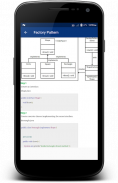








Design Patterns in Java

وصف لـDesign Patterns in Java
✴ Design patterns are programming language independent strategies for solving the common object-oriented design problems. That means, a design pattern represents an idea, not a particular implementation.✴
► By using the design patterns you can make your code more flexible, reusable and maintainable. It is the most important part because java internally follows design patterns.✦
► To become a professional software developer, you must know at least some popular solutions (i.e. design patterns) to the coding problems.✦
【Topics Covered in this App are Listed Below】
⇢ Design Pattern – Overview
⇢ Factory Pattern
⇢ Abstract Factory Pattern
⇢ Singleton Pattern
⇢ Builder Pattern
⇢ Prototype Pattern
⇢ Adapter Pattern
⇢ Bridge Pattern
⇢ Filter/Criteria Pattern
⇢ Composite Pattern
⇢ Decorator Pattern
⇢ Facade Pattern
⇢ Flyweight Pattern
⇢ Proxy Pattern
⇢ Chain of Responsibility Pattern
⇢ Command Pattern
⇢ Interpreter Pattern
⇢ Iterator Pattern
⇢ Mediator Pattern
⇢ Memento Pattern
⇢ Observer Pattern
⇢ State Pattern
⇢ Null Object Pattern
⇢ Strategy Pattern
⇢ Template Pattern
⇢ Visitor Pattern
⇢ MVC Pattern
⇢ Business Delegate Pattern
⇢ Composite Entity Pattern
⇢ Data Access Object Pattern
⇢ Front Controller Pattern
⇢ Intercepting Filter Pattern
⇢ Service Locator Pattern
⇢ Transfer Object Pattern
⇢ Eager initialization
⇢ Lazy initialization
⇢ Static block initialization
⇢ Bill pugh solution
⇢ Background information of factory pattern
⇢ Strategy Design Pattern
⇢ Single Responsibility Principle
⇢ The Open/Closed Principle and Strategy Pattern
⇢ Liskov’s Substitution Principle (LSP)
⇢ Interface Segregation Principle (ISP)
⇢ The Dependency Inversion Principle
⇢ Copy Constructor in Java
⇢ Cloning using In-memory Serialization
⇢ Fluent Interfaces
⇢ Using Enum
⇢ Adding readResolve()
⇢ Adding a serial version id
⇢ The Vector Class


























